Graph Representations
In graph theory, a graph representation is a technique to store graph into the memory of computer.
To represent a graph, we just need the set of vertices, and for each vertex the neighbors of the vertex (vertices which is directly connected to it by an edge). If it is a weighted graph, then the weight will be associated with each edge.
There are different ways to optimally represent a graph, depending on the density of its edges, type of operations to be performed and ease of use.
1. Adjacency Matrix
- Adjacency matrix is a sequential representation.
- It is used to represent which nodes are adjacent to each other. i.e. is there any edge connecting nodes to a graph.
- In this representation, we have to construct a nXn matrix A. If there is any edge from a vertex i to vertex j, then the corresponding element of A, ai,j = 1, otherwise ai,j= 0.
Note, even if the graph on 100 vertices contains only 1 edge, we still have to have a 100×100 matrix with lots of zeroes.
- If there is any weighted graph then instead of 1s and 0s, we can store the weight of the edge.
Example
Consider the following undirected graph representation:
Undirected graph representation
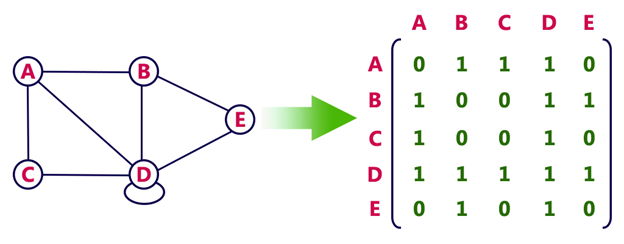
Directed graph represenation
See the directed graph representation:
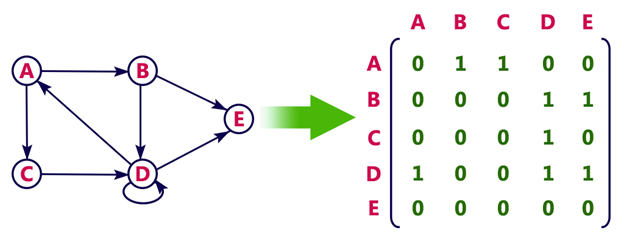
In the above examples, 1 represents an edge from row vertex to column vertex, and 0 represents no edge from row vertex to column vertex.
Undirected weighted graph represenation
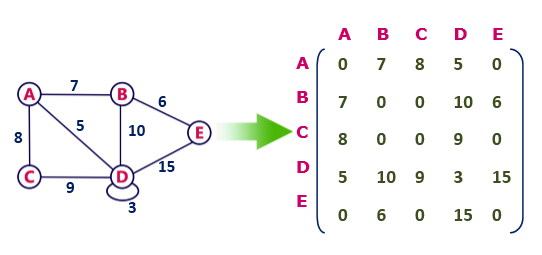
Pros: Representation is easier to implement and follow.
Cons: It takes a lot of space and time to visit all the neighbors of a vertex, we have to traverse all the vertices in the graph, which takes quite some time.
2. Incidence Matrix
In Incidence matrix representation, graph can be represented using a matrix of size:
Total number of vertices by total number of edges.
It means if a graph has 4 vertices and 6 edges, then it can be represented using a matrix of 4X6 class. In this matrix, columns represent edges and rows represent vertices.
This matrix is filled with either 0 or 1 or -1. Where,
- 0 is used to represent row edge which is not connected to column vertex.
- 1 is used to represent row edge which is connected as outgoing edge to column vertex.
- -1 is used to represent row edge which is connected as incoming edge to column vertex.
Example
Consider the following directed graph representation.
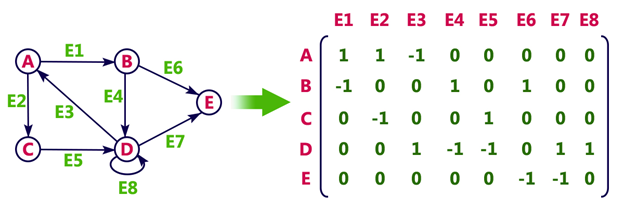
3. Adjacency List
- Adjacency list is a linked representation.
- In this representation, for each vertex in the graph, we maintain the list of its neighbors. It means, every vertex of the graph contains list of its adjacent vertices.
- We have an array of vertices which is indexed by the vertex number and for each vertex v, the corresponding array element points to a singly linked list of neighbors of v.
Example
Let’s see the following directed graph representation implemented using linked list:

We can also implement this representation using array as follows:
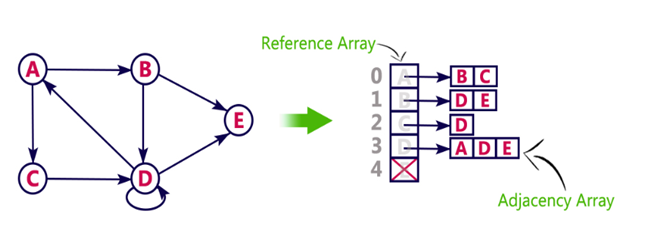
Pros:
- Adjacency list saves lot of space.
- We can easily insert or delete as we use linked list.
- Such kind of representation is easy to follow and clearly shows the adjacent nodes of node.
Cons:
- The adjacency list allows testing whether two vertices are adjacent to each other but it is slower to support this operation.
